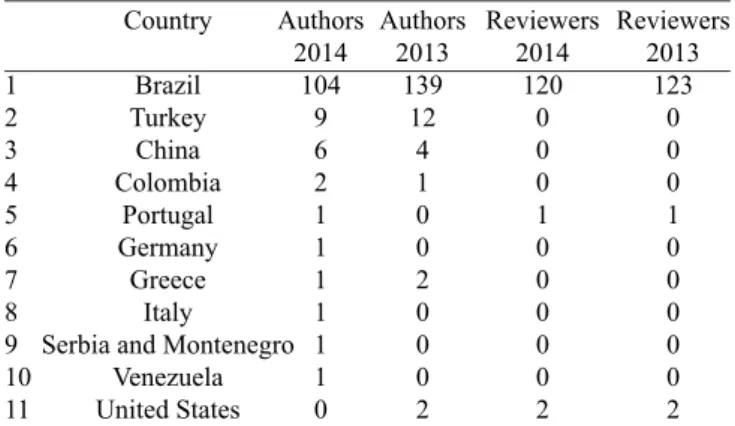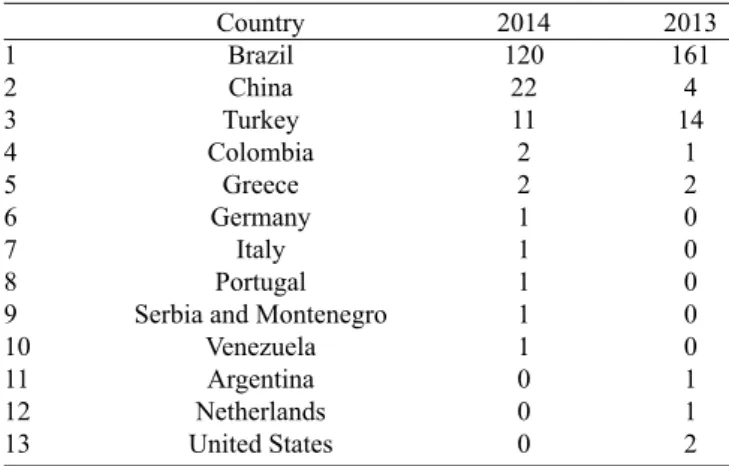I
Braz J Cardiovasc Surg | Rev Bras Cir Cardiovasc he scientiic paper is one of the most visible areas of
science. It is disseminating his ideas, new techniques and discoveries that the scientist, whether he is doc -tor, physician, biologist, engineer etc., plays his role in the expansion of knowledge and the consequent beneit to society and may break paradigms. This process is not simple, as we know, going through a series of bottlenecks ranging from consulting the relevant literature, research, data compilation, writing, journal’s choice, where it passes through the sieve of the reviewers, inal approval by the Editor and inally adjust -ments, in minor or major ways, until its release/publication.
Currently, the requirements are higher, either because postgraduate school to which the author is connected requires publishing studies in journals with higher impact factor (IF), depending on the CAPES criteria (Qualis Capes)[1], in the
case of Brazil, or the need for the article is written in English so it can be read, and eventually cited by the greatest number of readers.
In choosing a journal until the speed of dissemination of knowledge on the Internet, it is important, since today’s novelty turns into something “outdated” tomorrow.
Aware of this new scenario, scientiic journals have sought to reine their acceptance criteria and publishing articles. The Scielo has encouraged the journals that are part of its regular basis to take action accordingly. This creates a side effect, which is the increasing rejection of studies, either in submis -sion or during the review process. In journals from various ields, not only among the best known, the rate of rejected manuscripts exceeds 90%[2]. In The Lancet, for example, it
is 95%[3]. In journals restricted to a speciic area such as the
Brazilian Journal of Cardiovascular Surgery (BJCVS), the percentage is somewhat lower, but has been increasing over the years.
The BJCVS, aware that despite the new additions in recent years it still has a long way to go, has not measured efforts to walk “pari passu” with the best-known journals. Our rejection rate is rising gradually. In 2013, of 186 studies received, 61 were rejected (32.79%). In 2014, we received 162 manuscripts and 70 were rejected (43.21%). The average time between the submission of the study and the decision to approve or reject fell 147 days in 2013 to 86 days in the last year (Table 1).
Editorial
The scientiic article and the good science
Domingo M. Braile
1DOI: 10.5935/1678-9741.20150064
O artigo cientíico e a boa ciência
This shows our commitment to rigor and good science. Reviewers, also Brazilians overwhelmingly (Table 2), have been instructed to be strict and in some cases the study, when it is appropriate and does not have methodological errors, can incorporate adaptations suggested by the editor and reviewers, to be formatted according to the journal’s standards and stand ready to be published in hard copy and/or electronic form.
T
Table 1. Number of manuscripts received, approved and rejected by the Brazilian Journal of Cardiovascular Surgery in 2013 and 2014*
Total 2013
186 104 61 147
1 2 3
4
Item
Articles Sent Articles Approved
Articles Refused
Time between submission and approval (days) Total 2014 162
65 70 96
* The difference between the total number and sum of approved and
disapproved articles justiied by the fact that not all articles received in a given year are published in the same year of submission, as in
the case in question.
Source: GN1 Sistemas e Publicações.
Table 2. Countries of origin of authors and reviewers of manuscripts submitted to Brazilian Journal of Cardiovascular Surgery in 2013 and 2014.
Authors 2013
139
12
4
1
0 0
2
0 0 0
2 1
2 3
4 5 6 7 8 9 10
11
Country
Brazil Turkey
China
Colombia Portugal Germany
Greece
Italy
Serbia and Montenegro Venezuela
United States
Authors 2014
104 9 6
2 1 1 1 1 1 1
0
Source: GN1 Sistemas e Publicações.
Reviewers 2014
120 0 0 0
1
0 0 0 0 0
2
Reviewers 2013
123
0 0 0
1
0 0 0 0 0
II
Braz J Cardiovasc Surg | Rev Bras Cir Cardiovasc Table 3. Countries of origin of the manuscripts submitted to Brazilian
Journal of Cardiovascular Surgery in 2013 and 2014.
2013 161
4 14
1 2
0 0 0 0 0
1 1 2 1
2 3
4 5 6 7 8 9 10
11 12 13
Country Brazil
China
Turkey Colombia
Greece
Germany Italy Portugal Serbia and Montenegro
Venezuela Argentina Netherlands
United States
2014 120
22 11 2 2 1 1 1 1 1
0 0 0
Source: GN1 Sistemas e Publicações.
Table 4. Countries of origin of the manuscripts rejected by the Brazilian Journal of Cardiovascular Surgery in 2013 and 2014. Without Referee 2013
18 4
1
0 0 0
1
0
1 2 3
4 5 6 7 8
Country Brazil Turkey
China
Germany Argentina Colombia
Greece
Netherlands
Without Referee 2014 25
5 4
1
0 0 0 0
Source: GN1 Sistemas e Publicações.
With Referee 2014 27
0 7 0 0
1
0 0
With Referee 2013
31 2 2
0
1
0 0
1
Seeking the rapid spread of the item after the approval, pending the publication of a new issue of the journal the manuscript is available “ahead of print” already with the DOI (Digital Object Identiier) allowing its citation in the literature.
Despite all our efforts to internationalize the BJCVS, it is still an eminently Brazilian journal. In 2013, of the total num -ber of items received, 161 were from Brazil, followed by 14 from Turkey, 4 from China, 2 from the United States, 2 from Greece, 1 from Argentina, 1 from Colombia and 1 from the Netherlands. In 2014, 120 were from Brazil, 22 from China, 11 from Turkey, 2 from Colombia, 2 from Greece and 1 from Germany, 1 from Italy, 1 from Portugal, 1 from Serbia and 1 from Venezuela (Table 3).
Due to the largest number of studies received, Brazil was the country with the largest number of rejected manuscripts (Table 4).
With the adoption of English as the oficial language of the journal, six issues a year and a greater increase in disclosure, we hope to receive more international quality studies, and also from Brazil.
Without being redundant, I explain the reason to emphasize that the studies should be of quality and international. I see this as the only way to see our IF increase because the chance of readers of BJCVS to cite our journal in other publications that also are in the Thomson database and the Scopus increases in parallel to these parameters.
Redalyc
Aiming to expand our visibility, after various re -quirements and a long time in another database, the Re -dalyc admitted us (http://www.redalyc.org/). Based in Mexico, Redalyc has nearly 1,000 open access journals, allowing the dissemination of scientific information.
30 years
As we reported in previous editions, we are preparing, together with the Board of the Brazilian Society of Cardio -vascular Surgery (BSCVS), several activities to commemorate the 30th anniversary of the BJCVS. In programming of the
43rd Brazilian Congress of Cardiovascular Surgery, which
will take place from 7 to 9 April 2016, in Fortaleza, there will be a module in the programming dedicated to our journal, where we discuss topics of interests of authors, reviewers and professionals of health ield in general, who are interested in scientiic production. We will also pay tribute to our partners, who over these nearly three decades spared no efforts so that the BJCVS could be what it is today.
We trust that even facing many obstacles, never interrupting the circulation, the perspective is positive for us to continue our successful track record. The journal is available on multiple plat -forms, is present in social networks and always attentive to new technology and, of course, always trying to improve its content.
CME
III
Braz J Cardiovasc Surg | Rev Bras Cir Cardiovasc after coronary artery bypass grafting” (page 443); “Evaluation
of the inluence of pulmonary hypertension in ultra-fast-track an -esthesia technique in adult patients undergoing cardiac surgery” (page 449); “Effects of intraoperative diltiazem infusion on low changes in arterial and venous grafts in coronary artery bypass graft surgery” (page 459). I emphasize that the CME is a valuable tool for learning and updating of knowledge and is worth 0.5 points in the BJSVC proof of title. We are open to suggestions and criticisms to improve the system.
My warmest regards,
Domingo Braile
1Editor-in-Chief - BJCVS/RBCCV
REFERENCES
1. Brasil. Ministério da Educação. Fundação CAPES. Classiicação da Produção Intelectual [Cited 2015 Aug 18]. Available from: http://www.capes.gov.br/avaliacao/instrumentos-de-apoio/ classiicacao-da-producao-intelectual
2. American Psychological Association. Journals Statistics and Operation Data. 2013 Statistics [Cited 2015 Aug 1]. Available from: http://www.apa.org/pubs/journals/features/2013-statistics.pdf

